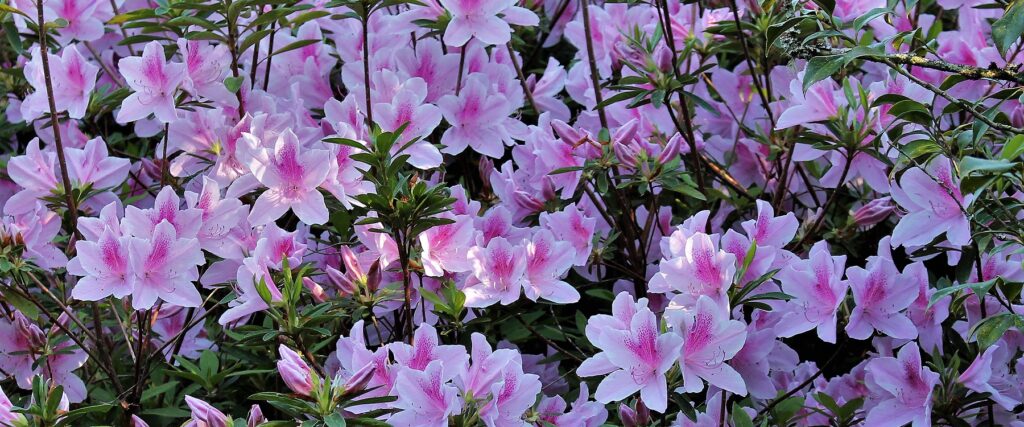It is time to apply 15-0-15 Centipede Lawn Fertilizer. This works on all types of warm season grasses we grow, namely, St. Augustine, Centipede, Zoysia and Bermuda. This formulation will ease your grass into fully greening up. Once that happens, you can go after any weeds you may have. Please avoid using “Weed & Feed” products until your grass is fully greened up and actively growing. You can also put down any fungicides or insect controls to prevent problems you may have had last year. Feel free to email me at rhowie@hyamsgardencenter.com with any questions. Our phone lines have been overwhelmed with calls and may be hard to get through. (Randy Howie)
What Does the Gardener Say?
Designing a Butterfly Garden
Butterflies are flowers with wings. These winged beauties delight our hearts as they flutter around in our garden. If you are designing a ‘Butterfly Garden,’ then you need to pay attention to some of the following points.
CLIMATE
Butterflies usually make their appearance in the spring once temperatures are above 60 degrees Fahrenheit, and stay around through autumn. Butterflies fly best when their body temperature is between 85 and 100 degrees. If temperatures dip below 80 degrees, you may spot butterflies basking in the sun with their wings outstretched, absorbing the heat. A flat rock is often included in butterfly gardens for this purpose.
SHELTER
Butterflies require a sheltered location to rest and seek protection from bad weather. During the night they roost on the underside of leaves or hide in shrubs and tall grasses.
PUDDLES
Often times you will observe a crowd of butterflies around puddles of water, this is known as “puddling.” It is thought that butterflies are attracted to puddles because they contain and dissolve minerals in which butterflies need to supplement their diet. You may think about placing a shallow birdbath or shallow dish in your garden to attract butterflies.
HIBERNATION
Except for the migratory Monarch butterfly, most butterflies hibernate at the same place that they spend their summer. Butterflies look for places such as loose bark, wood piles, or buildings to hibernate in. Some butterflies over-winter as adults, others as pupa and some as caterpillars. Many people like to place a “Butterfly House” in their gardens, meant to provide shelter to some species for hibernation. Situate your “Butterfly House” in the woodiest section of your garden, near a host plant to increase your chances of occupation.
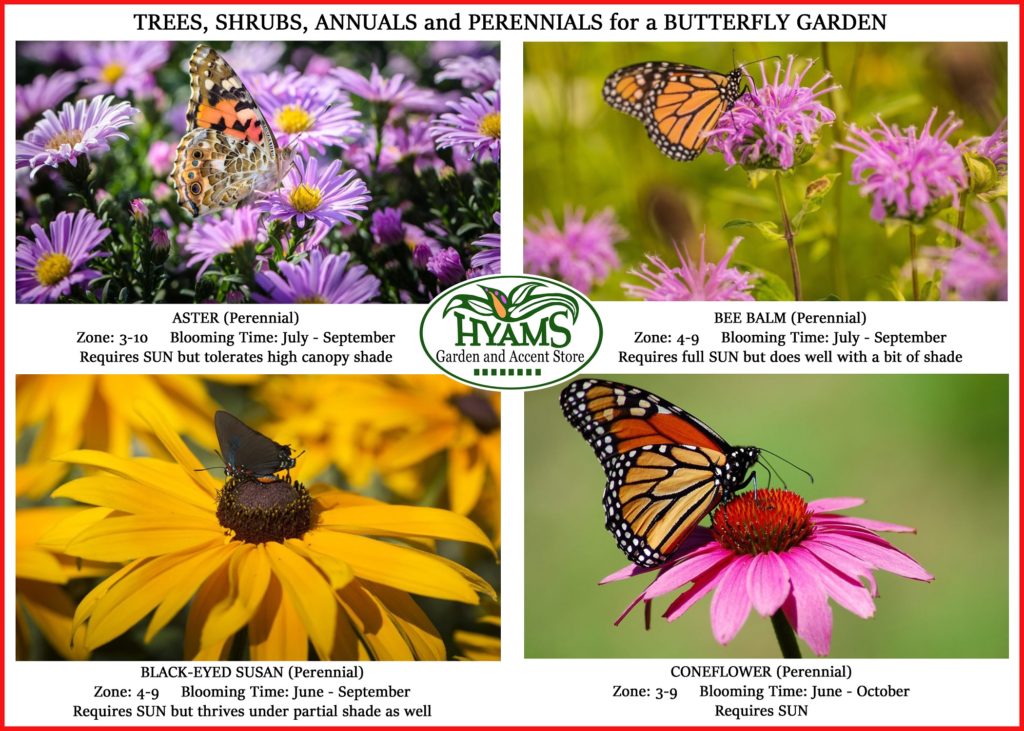
Shrubs, Trees, Perennials and Annuals that are suitable for a BUTTERFLY GARDEN
Butterflies play an important role in pollinating plants. They thrive around shrubs, trees, perennials and annuals that provide them nectar. It is a sugary solution that gives adult butterflies their energy. However, a sensible butterfly garden designer also thinks of the caterpillars. They do not eat nectar but live on leaves and plants. Shrubs, trees, vegetables and even pesky weeds are host plants for caterpillars. Female butterflies lay their eggs only on suitable host plants as the emerging young ones cannot travel far to find food. Since caterpillars heavily munch on the plants, it may be a wise gardening strategy to plant them in areas of the garden that are not easily visible to visitors.
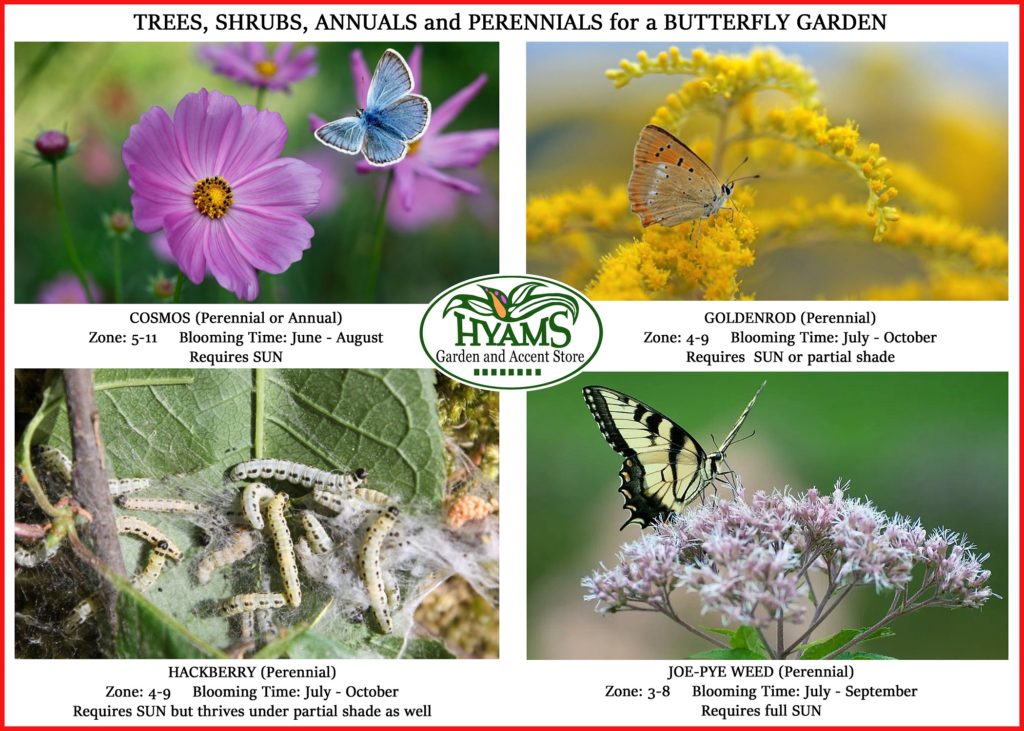
Butterfly Shrubs and Trees
Abelia (glossy)
Buddleia or Butterfly Bush (Buddleia Davidii)
Blueberry (Vaccinium species)
Citrus
Hawthorn (Crataegus species)
Privet (Ligustrum spp.)
Red bud (Crecis)
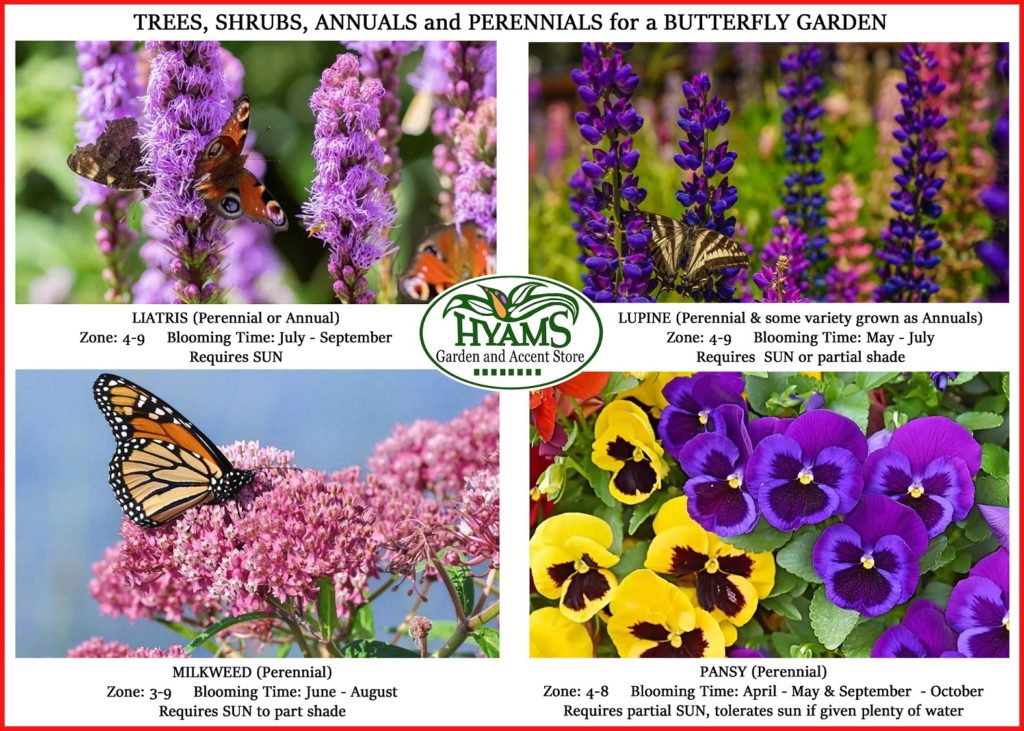
Butterfly Annuals
Cosmos
Dill
Fennel
Globe Amaranth (Gomphrena globosa)
Impatiens
Marigolds
Nasturtium
Parsley
Sunflower
Queen Anne’s lace
Verbena
Zinnia
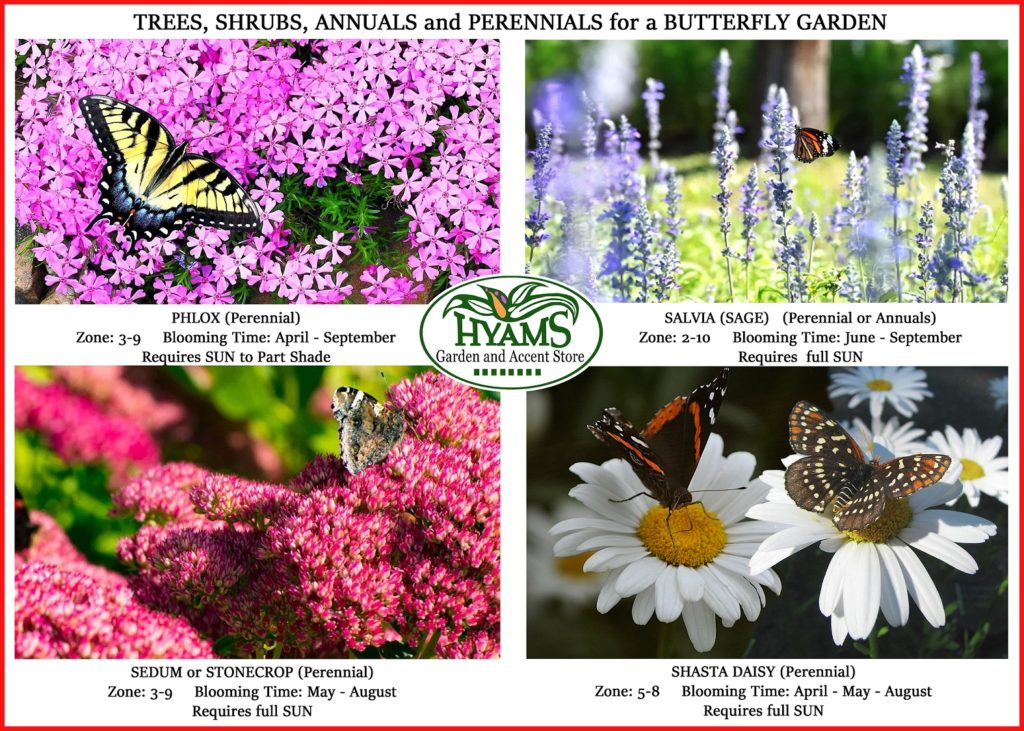
Butterfly Perennials
| Ageratum Aster Bee-balm (Monarda) Black-eyed Susan (Rudbeckia) Bugle (Ajuga Reptans) Butterfly weed (Asclepias tuberosa) Chives Coneflower (Echinacea purperea) Coreopsis Daylily (Hemerocallis species) False Indigo (Baptisia australis) Gayfeather (Liatris species) | Godenrod (Solidago species) Hibiscus Hollyhock (Altheaa rosea) Joe-Pye Weed Lantana (Lantana camara) Lobelia (Lobelia cardinalis) Milkweed (Asclepias species) Passion Flower (Passiflora) Phlox (Phlox paniculata) Sage (Salvia leucantha) Sedum Verbena Yarrow (Achillea species) |
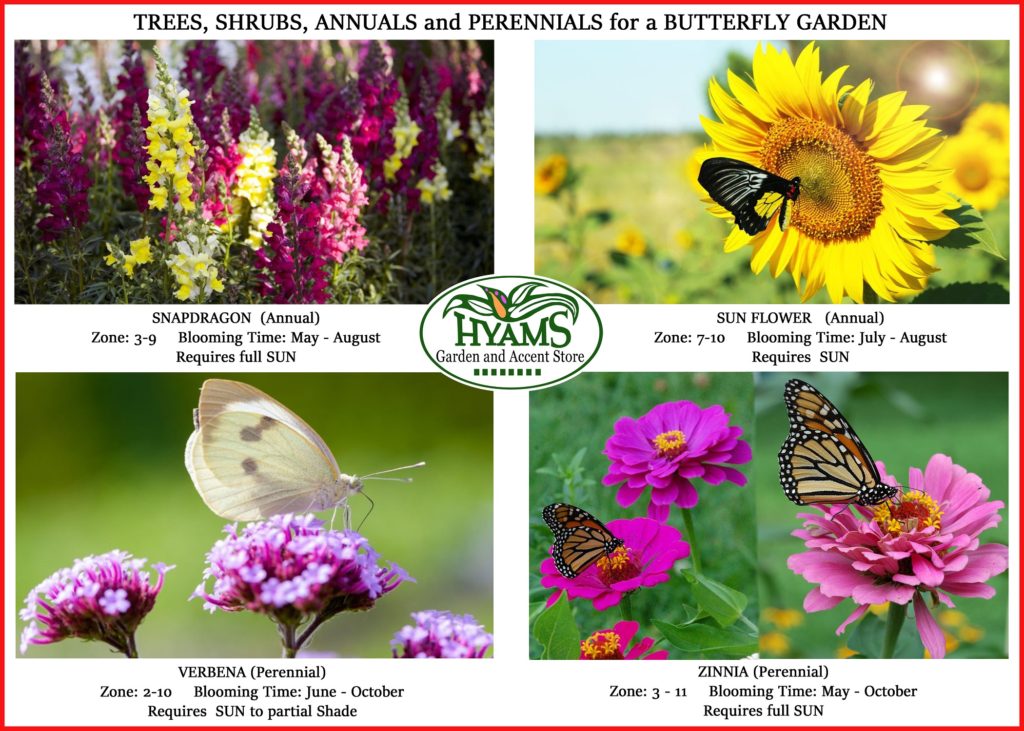
Raised Bed Gardening
Lots of people like to have ‘Raised Garden Beds’ to grow flowers, herbs and vegetables. These are relatively easy to construct and maintain. Raised Bed gardening has many benefits.
What is a ‘Raised Garden Bed?’
A raised garden bed is basically a large planting container that sits above ground and is filled with soil and plants. It is a box with no bottom or top, that is to say, a frame which is placed in a sunny spot and is filled with good quality soil to cultivate vegetables, herbs and flowers. For many a ‘Raised Garden Bed’ is a source of pride and pleasure and is a centerpiece of their garden.
Dimensions of a ‘Raised Garden Bed’
A ‘Raised Garden Bed’ does not have to be very deep to be effective. Vegetable beds should be 12 to 18 inches deep. Plants that require drier soil may need taller boxes with porous growing medium. ‘Raised Garden Beds’ come in different dimensions. However, most people start with a 4 feet wide, 4 feet long and 1 foot deep (4x4x1) bed. This dimension is easier to maintain as the gardener can access it comfortably from all sides. Larger dimensions make it harder to weed and harvest. Multiple beds of the same dimensions can be made and arranged aesthetically in the garden to grow different crops.
‘Raised Garden Beds’ need a location that has level ground and gets right amount of sunlight, that is to say, 6 to 8 hours per day. The site for beds must be prepared by breaking up and loosening the soil underneath so that it is not compacted. Digging 6 to 8 inches deep and mixing the top layer of soil with the soil below a spade’s depth improves rooting. Because many plants require well-draining soil, placing rocks in the bottom of a raised bed to create additional drainage space below the soil is a sensible step. Unlike soil, rocks will not degrade or compact over time.
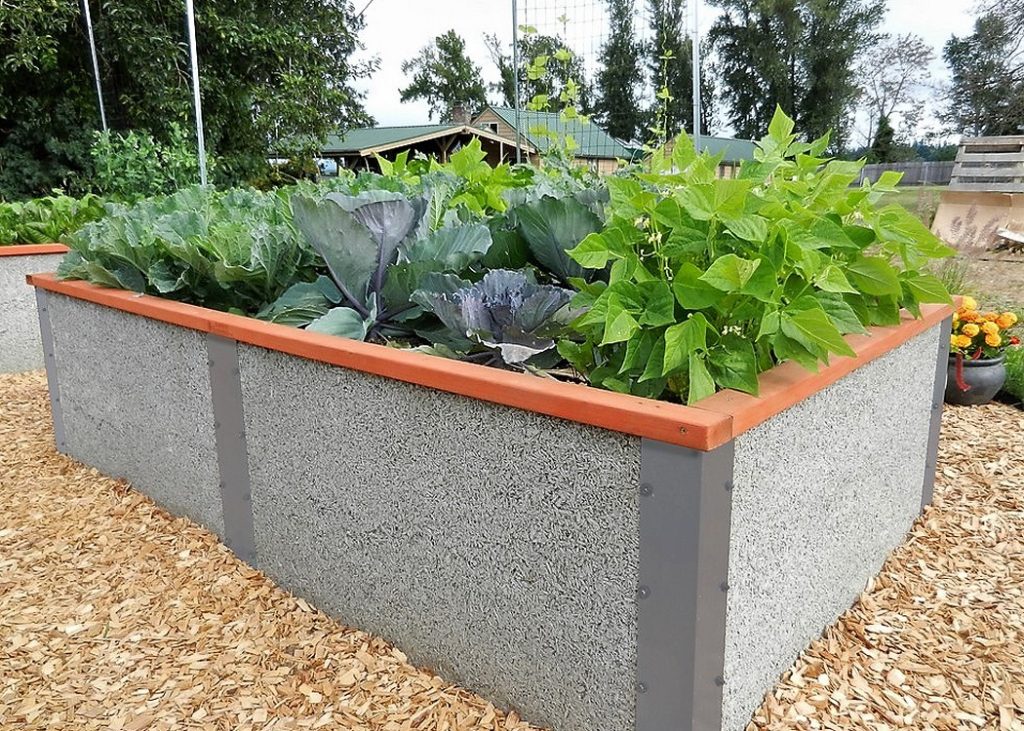
Wood, Concrete or Galvanized Metal for the Raised Bed?
A ‘Raised Garden Bed’ can be constructed using wood or galvanized metal. Using the right wood to make the boxes is very important. CCA pressure-treated wood is banned as it can leach arsenic into the soil. Regular pressure-treated lumber can be used as it is certified safe for organic growing. Cedar is the most preferred option as it contains natural oils which protect it from moisture breakdown and can last the longest, however, it can be more expensive. Alternatively, some like to build their beds with concrete blocks or bricks. However, it is important to keep in mind that the contents of concrete can negatively impact the pH of the soil and will require frequent soil amendments. Galvanized metal works well for building raised beds because the zinc coating helps prevent the metal from rusting. Without galvanization, the metal’s constant exposure to soil and moisture would cause the beds to fall apart within a year or two of use.
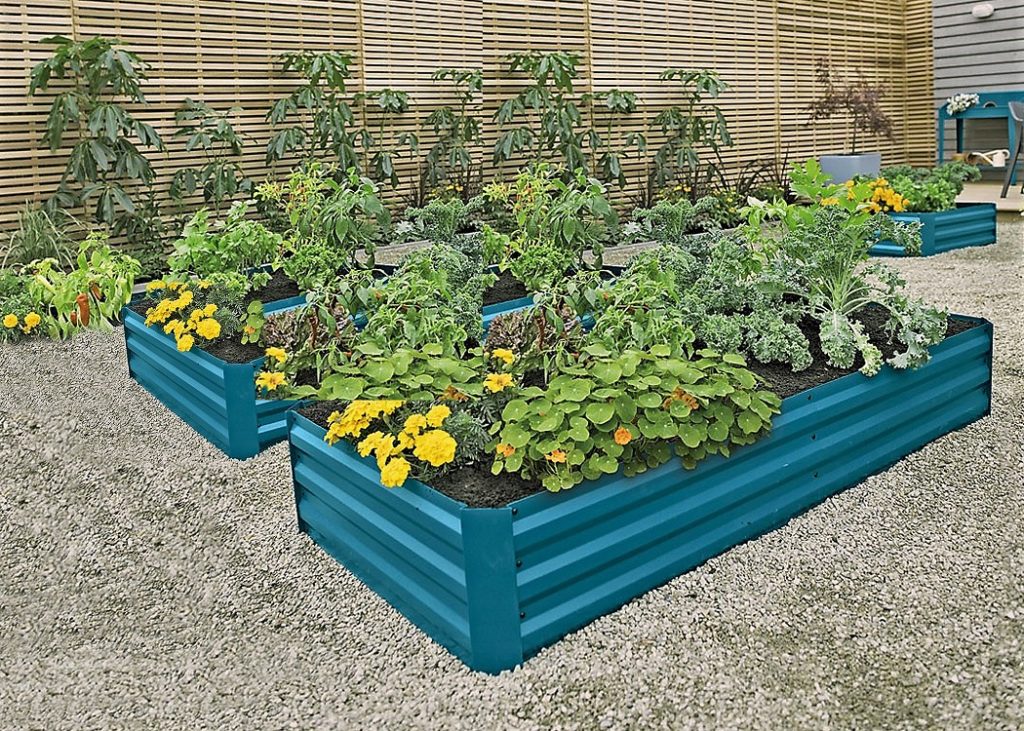
The Right Organic Mix to fill a ‘Raised Garden Bed’
The soil blend that you put into your raised bed is its most important ingredient. More gardens fail or falter due to poor soil than almost anything else. Fill the beds with a mix of topsoil, compost, and other organic material, such as manure, to give your plants a nutrient-rich environment. The soil in a raised bed tends to dry out more quickly. During the spring and fall, this is fine, but during the summer, add straw, mulch, or hay on top of the soil to help it retain moisture. Frequent watering will be critical with raised beds, especially in the early stages of plant growth. Otherwise, raised beds need little maintenance.
For a vegetable and herb bed of 4 feet by 4 feet by 1 foot (4 x 4 x 1 or 16 cubic feet), we at Hyams Garden Center recommend the following soil recipe:
- 1/3 Peat Moss – 1, 2.2 Compressed Bale = 5 cubic feet
- 1/3 Stout Ollie (blended compost) – 4, 1.5 cubic feet bags = 6 cubic feet
- 1/3 Vermiculite – 1, 4 cubic feet bag
For budget calculating purposes, the cost is approximately $4.75 per cubic foot as of summer of 2020.
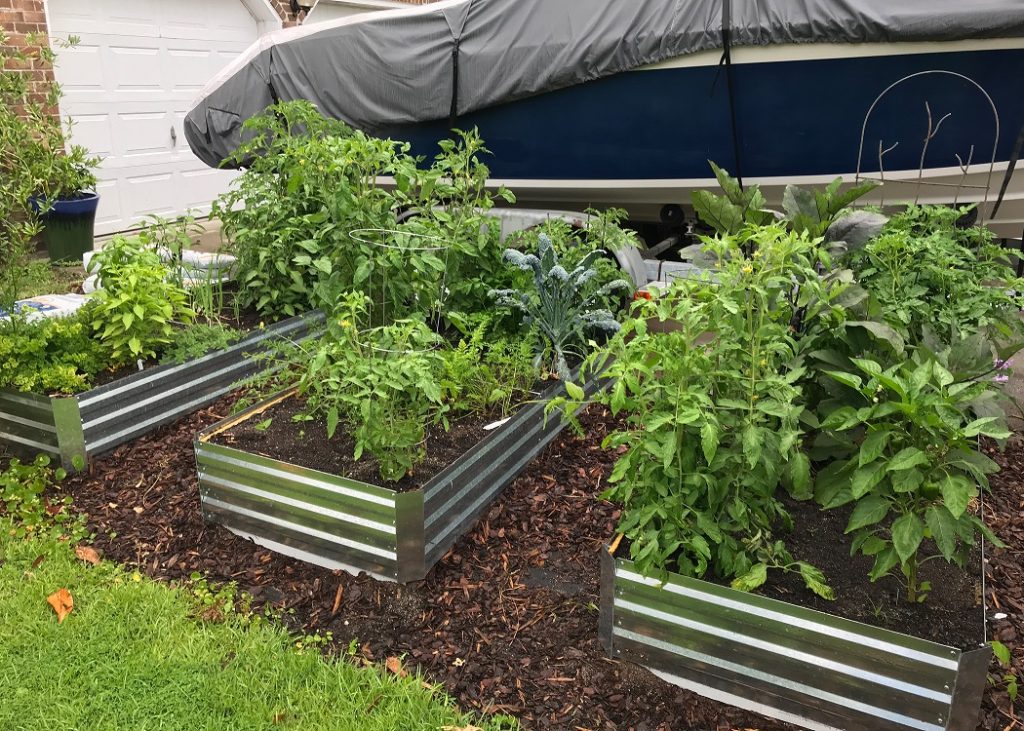
For a 4 feet by 8 feet (4 x 8) raised bed the soil recipe would be the following:
- 4 bags (2 cubic feet each) topsoil. Please avoid using topsoil from your yard, as it may contain weeds and pests.
- 2 pails (3 cubic feet each) coconut coir (to improve drainage)
- 2 bags (2–3 cubic feet each) compost or composted cow manure
- 2-inch layer of shredded leaves or grass clippings (grass clippings should be herbicide-and fertilizer-free)
Benefits of a ‘Raised Garden Bed’
- Garden chores are made easier and more comfortable thanks to less bending and kneeling. Save your knees and back from the strain and pain of tending the garden!
- Productivity of plants is improved due to better drainage and deeper rooting.
- Raised beds are ideal for small spaces where a conventional row garden might be too wild and unwieldy. Raised beds help to keep things organized and in check.
- Planting in a raised bed gives you full control over soil quality and content, which is especially important in areas where the existing soil is rocky, nutrient-poor, or riddled with weeds.
- Raised beds allow for a longer growing season, since you can work the soil more quickly in the spring in frost-hardened regions, or convert the bed into a cold frame in the fall.
- Fewer weeds are seen in raised beds thanks to the bed being elevated away from surrounding weeds and being filled with disease-and weed-free soil.
- Raised beds allow for easier square-foot gardening and companion planting.
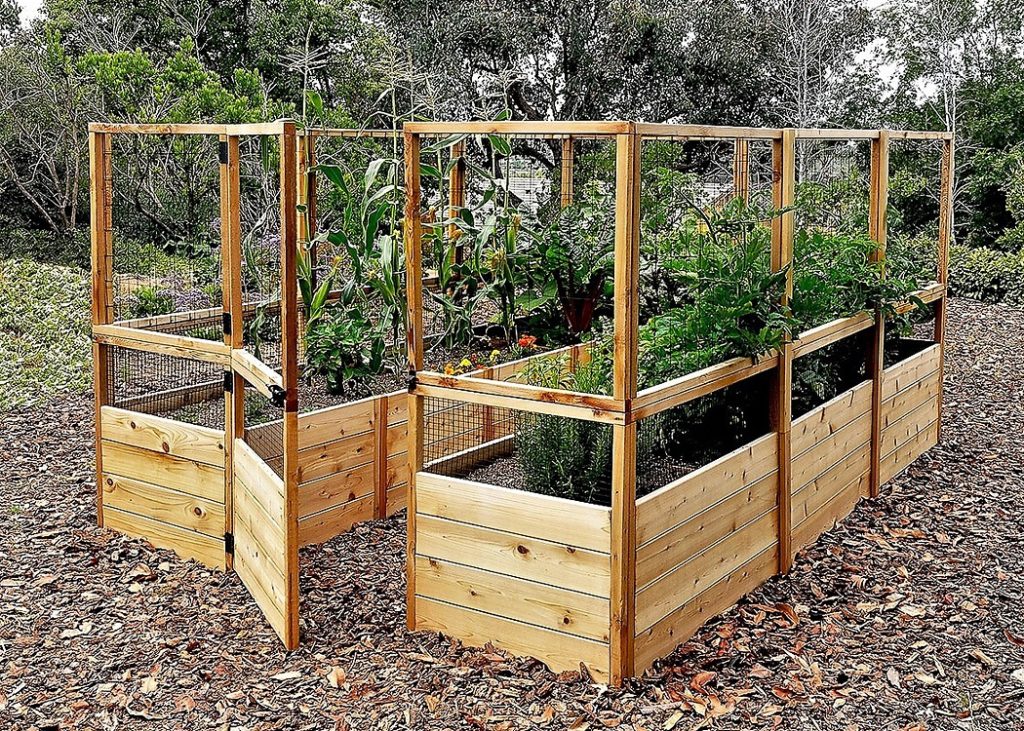
When to Plant what in your ‘Raised Garden Beds’
For Charleston, a good time to introduce starter plants to the ‘Raised garden Beds’ for the Fall Planting Season is when temperatures during the day are in the mid-80s and the nights are in the mid to low 70s Fahrenheit.
A good time to directly sow seeds into the bed is mid-September to mid-October. The best seeds to sow are root vegetables like carrots, beets, turnip, etc.
Vegetables best suited for ‘Raised Garden Beds’ are (1) leafy greens, (2) onions, (3) tomatoes and (4) potatoes.
Seed Planting: A Calendar for Charleston
| JANUARY | Beets Cabbage | Carrot Early Peas | Onion Sets Lettuce | Mustard Rutabaga | Spinach Turnips |
| FEBRUARY | Broccoli Cabbage | Collards Lettuce | Mustard Onion Sets | Potatoes Irish Radish | Rutabaga Turnips, Parsley |
| MARCH | Beans, Snap Beans Pole Beans Half Runner | Beans, Lima Broccoli Cantaloupes Collards | Corn Cucumbers Egg Plant Lettuce | Peas Peppers Radish Squash | Tomatoes Turnips Watermelon |
| APRIL | Beans, Lima Cantaloupes, Corn | Cucumbers Egg Plant Lettuce | Okra Peanuts Peppers | Southern Peas Squash | Tomatoes Watermelon |
| MAY | Beans, Lima Cantaloupes, Corn | Cucumbers Egg Plant Lettuce | Okra Peanuts Peppers | Southern Peas Squash | Tomatoes Watermelon |
| JUNE | Beans, Tomatoes | Egg Plant Okra | Sweet Potato Sets | ||
| JULY | Beans | Cucumber | Egg Plant | Okra | Tomato |
| AUGUST | Beans, Beets, Broccoli | Cabbage Cauliflower Collards | Cucumber Garlic Kale | Lettuce Mustard Onion Sets | Peppers Rutabaga Squash, Turnip |
| SEPTEMBER | Broccoli, Kale | Lettuce Mustard | Onion Sets Radish | Turnip | |
| OCTOBER | Mustard Onion Sets | Radish Lettuce | Rutabaga Spinach | Turnip | |
| NOVEMBER | Onion Sets | Radish | Spinach | ||
| DECEMBER | Beets | Cabbage | Carrot |
Which Vegetables Grow Well Together
The chart below provides quick and easy references for not only which vegetables grow well together, but which to avoid planting together.
| Vegetable | Companion Plant | Don’t Plant Together |
| Asparagus | Tomatoes | None |
| Beans (Bush or Pole) | Celery, corn, cucumbers, radish, strawberries and summer savory | Garlic and onion |
| Beets | Bush beans (not pole beans), cabbage, broccoli, kale, lettuce, onions, garlic | Pole beans |
| Cabbage Family (cabbage, broccoli, kale, Brussels sprouts) | Beets, celery, dill, Swiss chard, lettuce, spinach, onions, potatoes | Pole beans |
| Carrots | Beans, tomatoes | None |
| Celery | Beans, tomatoes, cabbages | None |
| Corn | Cucumber, melons, squash, peas, beans, pumpkin | Tomatoes |
| Cucumber | Beans, corn, peas, cabbage | None |
| Eggplant | Beans, pepper | None |
| Melons | Corn, pumpkin, radish, squash | None |
| Onions | Beets, carrots, Swiss chard, lettuce, peppers | All beans and peas |
| Peas | Beans, carrots, corn, cucumbers, radish, turnip | Garlic, onions |
| Potatoes | Beans, corn, peas | Tomatoes |
| Squash | Corn, melons, pumpkins | None |
| Tomatoes | Carrots, celery, cucumbers, onions, peppers | Corn, potatoes, kohlrabi |
Companion Planting and Organic Pest Control
Many old-fashioned vegetable gardens or kitchen gardens mix vegetables, herbs and flowers together. Not only does this type of garden look beautiful, but it also harnesses the power of nature to create an organic garden that naturally repels pests. Marigolds repel many species of insects. You can plant marigolds around tomatoes to inhibit the ugly green horn worms. These big insects can devour an entire tomato plant in one night. Plant marigolds around your entire vegetable garden to add bright color and keep the insect predators at bay.
Herbs add flavor to foods, and they can also discourage harmful insects. Nasturtium and rosemary deter beetles that attack beans. Thyme repels the cabbage worm. Chives and garlic deter aphids. Oregano, like marigolds, is a good all-purpose plant for the organic gardener who wants to deter most insects and pests. Plant herbs freely among vegetables, tucking basil, oregano, rosemary and chives in among the tomato and pepper plants. You can harvest the entire crop and make one great tasting dinner.
Companion Planting offers every gardener the chance to harness the power of nature for higher yields as well as natural, organic insect control. By tucking a few carefully chosen extra plants among the vegetables, you increase the garden yield and enjoy a bountiful harvest.
Vegetable Planting Guide
| Vegetable | Seeds or Plants? | When to Plant |
| Beans, snap or green | Sow seeds directly into the garden | Late Spring (after danger of frost has passed) |
| Beets | Sow seeds directly into the garden | Early to Mid-Spring |
| Broccoli | Start seeds indoors 6-8 weeks in spring or summer for fall | Transplant into garden early spring or late summer for fall crop. |
| Cabbage | Start seeds indoors 8 weeks before last frost date | Transplant into garden early spring or summer for fall. |
| Carrots | Sow seeds directly into the garden | Mid to Late Spring |
| Chard | Sow seeds directly into the garden | Early to Mid-Spring |
| Corn | Sow seeds directly into the garden | Late spring (after danger of frost has passed) |
| Eggplant | Start seeds indoors 8-12 weeks before last frost date | Transplant into garden late spring. |
| Lettuce | Sow seeds directly into the garden | Early to Mid-Spring |
| Peas | Sow seeds directly into the garden | Early to Mid-Spring |
| Peppers | Sow seeds indoors 8-12 weeks before last frost date | Transplant into garden late spring. |
| Pumpkin | Sow seeds directly into the garden | Late spring (after danger of frost has passed) |
| Radish | Sow seeds directly into the garden | Early to mid-spring |
| Spinach | Sow seeds directly into the garden | Early to mid-spring or fall |
| Squash | Sow directly or start indoors 6-8 weeks before last frost date | Late spring |
| Tomatoes | Sow seeds indoors 8-12 weeks before last frost date | Transplant into garden late spring. |
| Zucchini | Sow directly or start indoors 6-8 weeks before last frost date | Late spring |
Camellias: A Celebration of Love, Affection and Admiration
Grown for their flowers and often attractive foliage, CAMELLIAS are a genus of evergreen shrubs and small trees. They have long been valued for their luxuriant, rich green foliage and masses of showy flowers, in shades of white, pink, red and yellow, borne mainly in winter and spring.
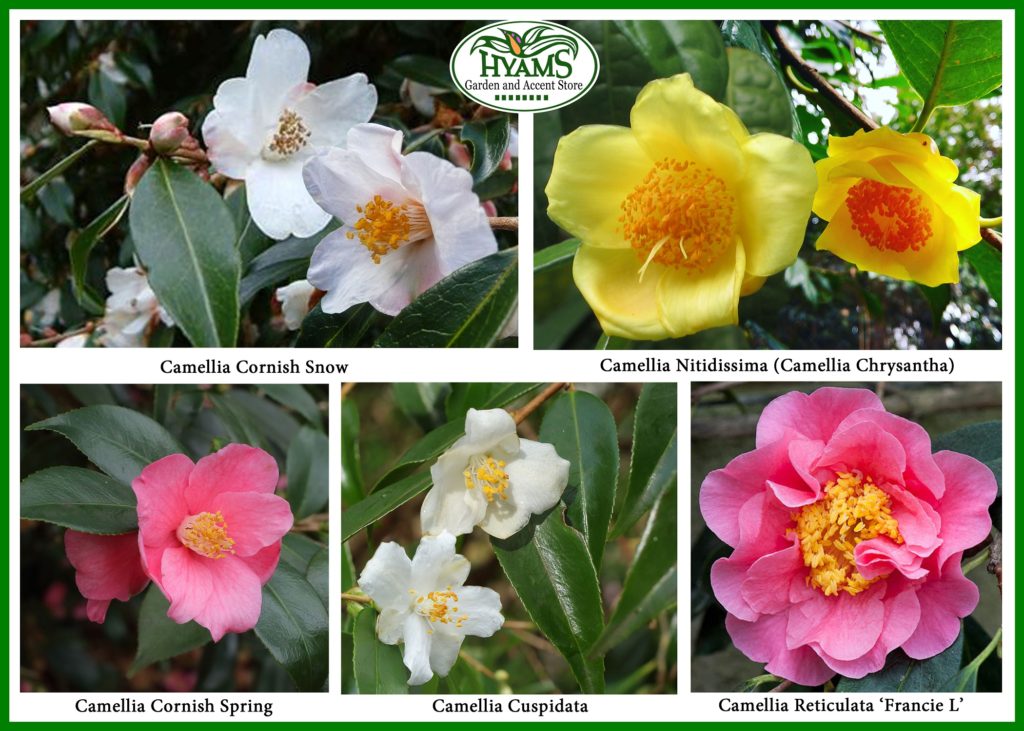
Camellias grow well against walls and in containers and are ideal for shady gardens. Once upon a time it was thought that camellias were suitable only for greenhouses. However, if grown in sheltered positions, many types of camellias have proved to be frost hardy to zone 6. Of course, their blooms do suffer frost and rain damage. Most types prefer a sheltered position and semi-shade. Well drained, neutral to acidic soil is essential to camellias. They need to be pruned to shape after flowering. Propagate by semi ripe or hardwood cuttings from midsummer to early winter or by grafting in late winter or early spring. Aphids, thrips, and scale insects may cause problems under glass.
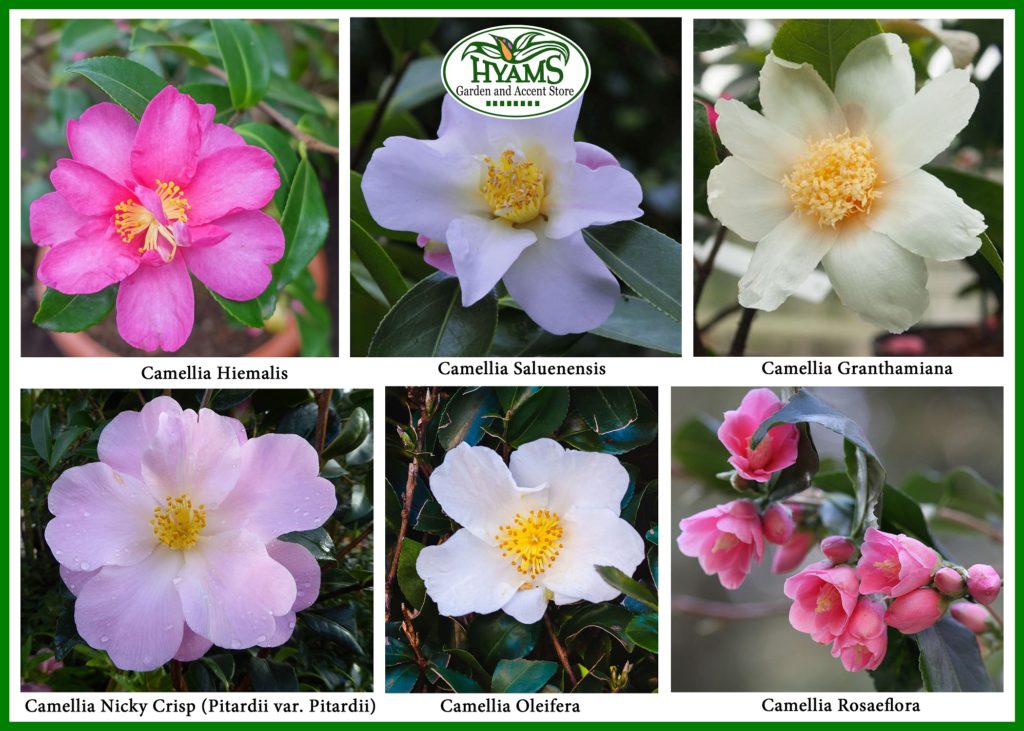
Camellias are classified according to the flowering types, namely, single, semi double, anemone-form, peony-form (sometimes termed irregular double), rose form and formal double. ‘Cornish Snow’ is a single form camellia while ‘Alba Plenna’ and ‘Black Lace’ are examples of formal double Camellia Japonica. ‘Debbie’ is a peony form hybrid between camellia and williamsii while ‘Nobilissima’ is a peony form camellia Japonica. ‘J. C. Williams’ single form hybrid between camellia and williamsii while ‘Jury’s Yellow’ is an anemone form hybrid between camellia and williamsii. ‘Lavinia Maggi’ is a formal double camellia Japonica while ‘Water Lily’ is a formal double hybrid between camellia and williamsii. ‘Inspiration,’ ‘Spring Festival’ and ‘Freedom Bell’ are semi double forms of camellia while ‘Hagoromo,’ ‘Janet Water House’ and ‘Tricolor’ are examples of semi double form Camellia Japonica.
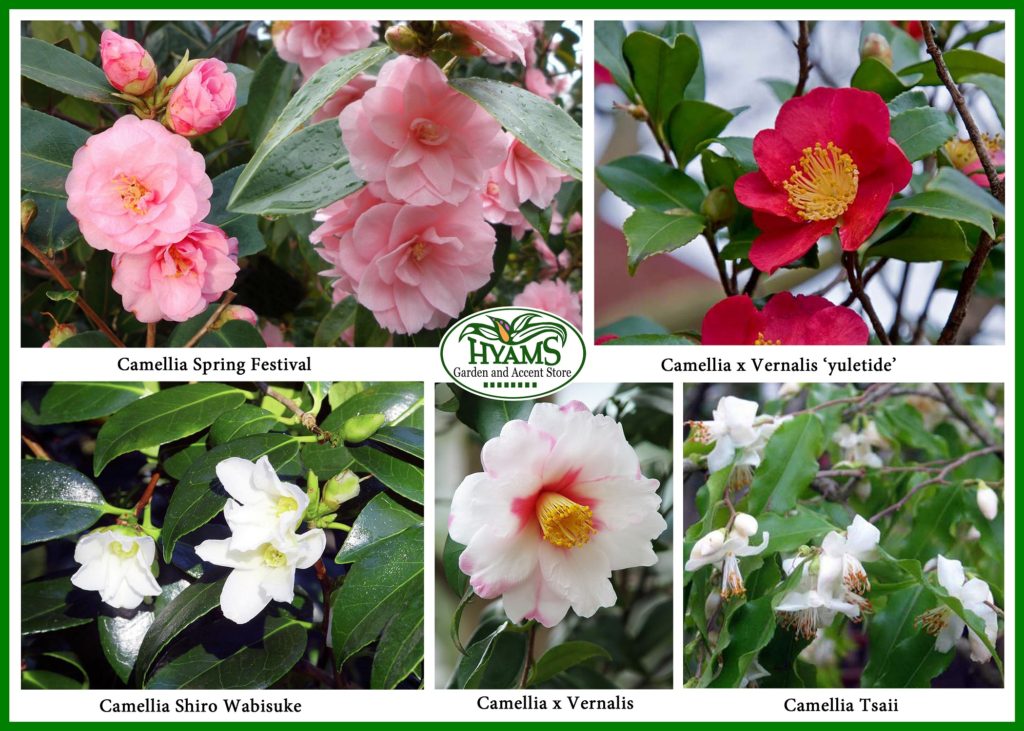
Flowers of ‘Single flowering type camellias’ have not more than 8 petals and are arranged in a single row with a conspicuous central boss of stamens. Flowers of ‘Semi double flowering type camellias’ have 2 or more rows of 9 to 21 regular or irregular petals and usually have conspicuous stamens. Flowers of ‘Anemone-form flowering type camellias’ have one or more rows large outer petals lying flat or undulating with a domed center having a mass of intermingled petaloids and stamens. Flowers of ‘Peony-form flowering type camellias’ have irregular petals intermingled with petaloids and stamens. ‘Rose-form flowering type camellias’ have several rows of overlapping petals and open to reveal a few stamens in the center. ‘Formal double flowering type camellias’ have rows of neatly overlapping petals that obscure the stamens.
“Encyclopedia of Plants and Flowers,” edited by Christopher Brickell, lists the following types of camellias:
Camellia ‘Black Lace’ (Camellia Reticulata) is a slow growing, dense, upright shrub with ovate, dark green leaves that produces large, formal double, deep velvet-red flowers from early to late spring. Camellia Black Lace is fit for zone 7 to 8.
Camellia Chrysantha (Camellia Nitidissima) is a fast growing, evergreen, open shrub or tree with large, ovate, leathery, veined, dark green leaves which occasionally produces small, stalked, single, clear yellow flowers from leaf axils in early spring. Camellia Nitidissima is fit for zone 7 to 8.
Camellia Cornish Snow (Camellia Cuspidata) is a fast growing, evergreen, upright, bushy shrub. It has lance-shaped leaves which appear bronze colored when they are young and dark green when matured. From late winter to spring this shrub bears a profusion of small single white flowers and is fit for zone 7 to 8.
Camellia Cornish Spring is a dense, compact, upright evergreen shrub with lance-shaped leaves that appear tinged-bronze when young. In spring it bears a profusion of small, single, bright pink flowers. This shrub is best in shade and is fit for zone 7 to 9.
Camellia Cuspidata is an evergreen, upright shrub that grows bushy with age. Its leaves are small and lance-shaped, bronze in color when young and look purplish green when mature. Small, single, pure white flowers bloom from its leaf axils in early spring. This Camellia is fit for zone 7 to 8.
Camellia Japonica is an evergreen shrub that is very variable in hardiness, habit, foliage and floral form. It is a cold tolerant shrub and some of its clones are among the most cold-resistant of the genus. It is fit for zone 7 to 8 and most of its cultivars flower in spring. The following are some of the Camellia Japonica Cultivars: Adelina Patti (single rose-pink flowers with white margins and golden yellow anthers), Adolphe Audusson (large, semidouble, dark red flowers with prominent yellow stamens), Alba Plena (large, formal double white flowers), Alba simplex b (single white flowers occasionally flecked pink), Alexander Hunter (single deep crimson flowers with some petaloids), Althaeiflora (large, peony-form, dark red flowers), Annie Wylam (two-tone pink peony-form flowers), Paul’s Apollo (semi-double red flowers sometimes blotched white), Berenice Body (semi-double light pink flowers), Betty Sheffield Supreme (loose peony-form flowers with white petals bordered with shades of rose pink), Bob Hope (large, semi-double or peony-form bright red flowers with golden stamens), Bob’s Tinsie (miniature anemone-form, brilliant red flowers), Brushfield’s Yellow (anemone-form cream flowers with a pale yellow center), Coquettii (medium to large deep red flowers usually formal double, at times peony-form), Desire (large, formal double, very pale pink flowers with darker pink margins), Elegans (anemone-form, deep rose-pink flowers with central petaloids often variegated white), Elizabeth Weaver (large coral-pink formal double flowers), Gloire de Nantes (semi double, bright rose pink flowers), Guilio Nuccio (large, semi double, rose red flowers with wavy petals and often a confused center of petaloids and golden stamens), Hagoromo (semi double, blush-pink flowers with scoop-shaped petals), Janet Waterhouse (semi double white flowers with golden anthers), Julia Drayton (large crimson flowers varying from formal double to rose form), Jupiter (large single pinkish-red flowers with golden stamens and white filaments), Kumasaka (formal double or peony form, deep rose pink flowers sometimes red-streaked with smaller inner petals), Lady Vansittart (Medium, semi double, white flowers with flushed rose-pink), Lavinia Maggi (formal double white flowers strongly striped and flecked with pink and carmine), Lily Pons (single or semi double white flowers with long spoon shaped petals), Lovelight (large, semi double, pure white flowers), Magnoliflora (synonym of Hagoromo), Margaret Davis (Peony form blooms, ruffled, creamy white petals with bright rose-red edges), Masayoshi (semi double, red flowers), Nobilissima (peony form, lemon tinted, white flowers), Nuccio’s Jewel (peony form white or pale pink flowers), Rubescens Major (formal double, crimson-veined, rose-red flowers), San Dimas (medium, semi double, rich red flowers with prominent golden-yellow stamens), Tricolor (synonymous with Camellia Japonica Sieboldii bears medium, single or semi double red flowers that are striped pink and white), Tomorrow Park Hill (irregular double flowers with pink outer petals), Tomorrow’s Dawn (pale pink flowers bordered white and often red-streaked).
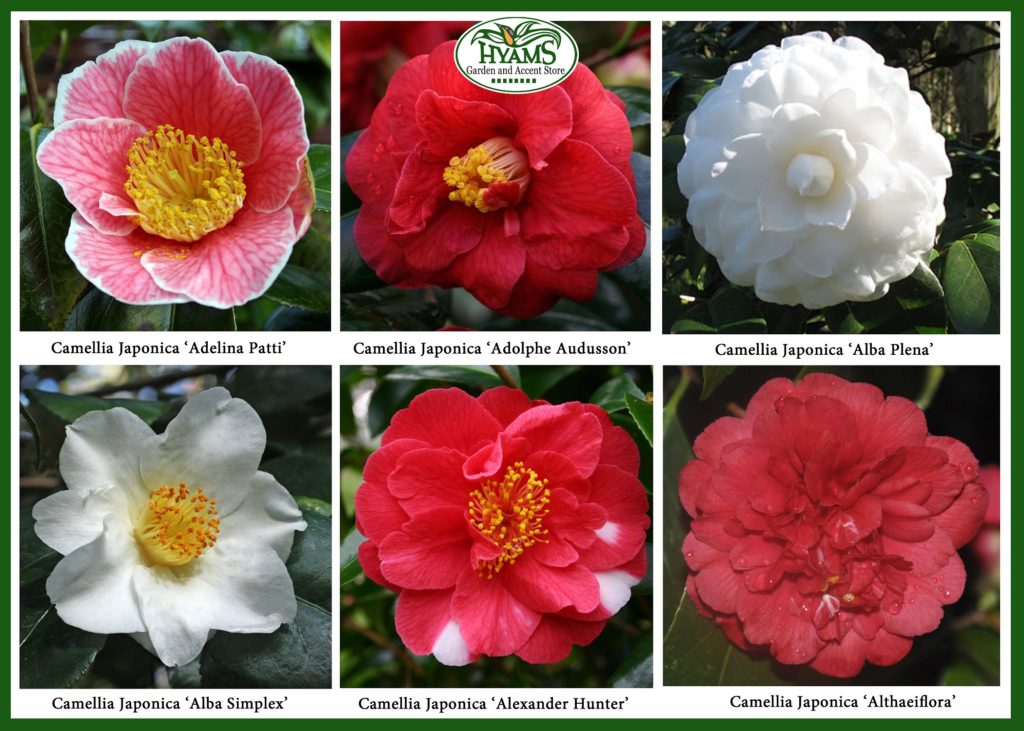
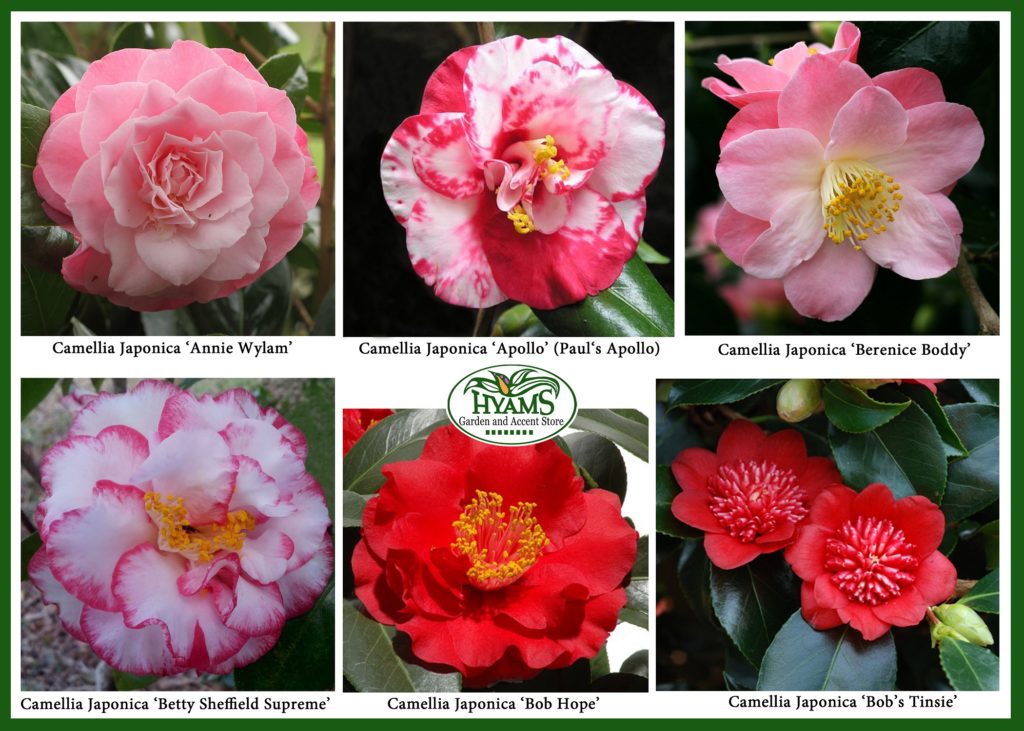
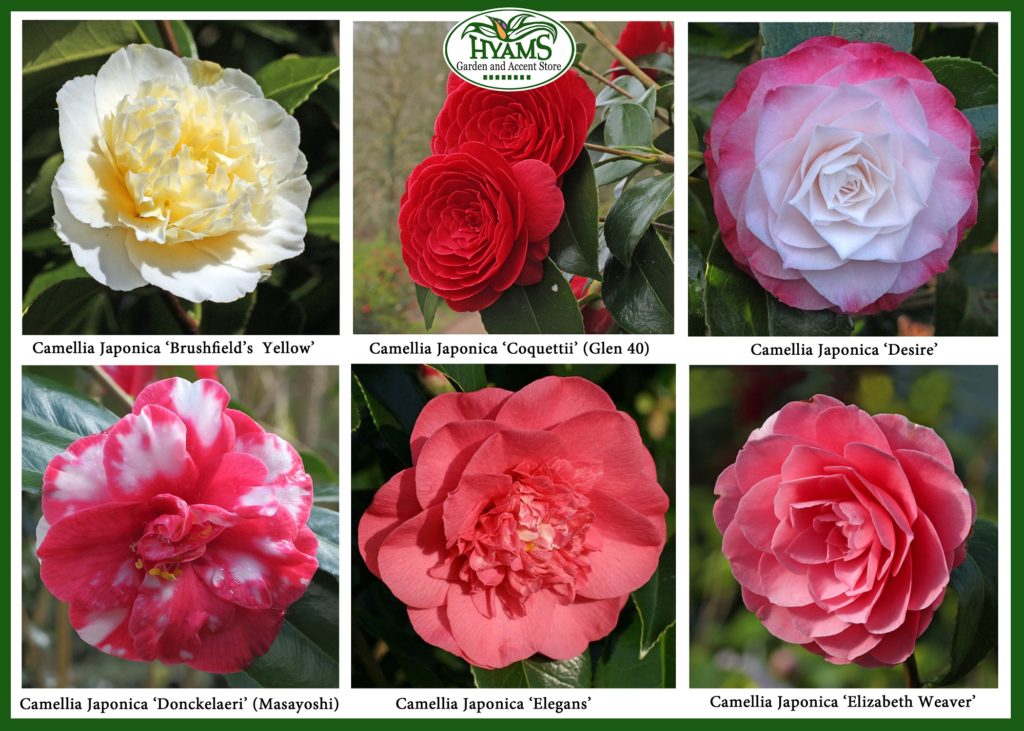
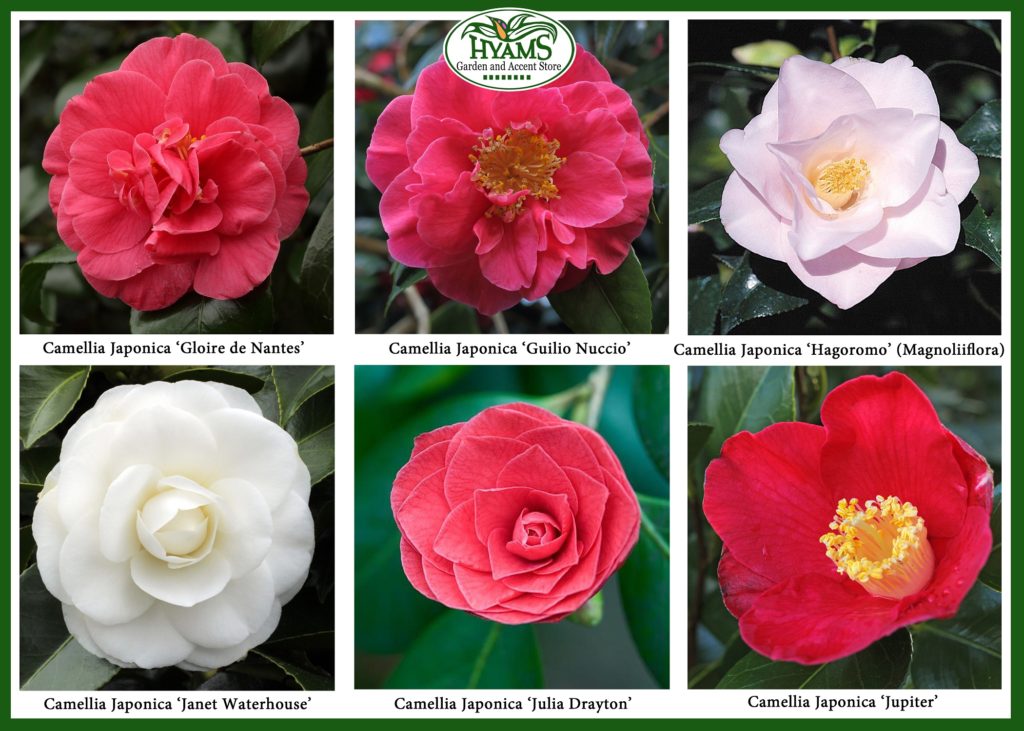
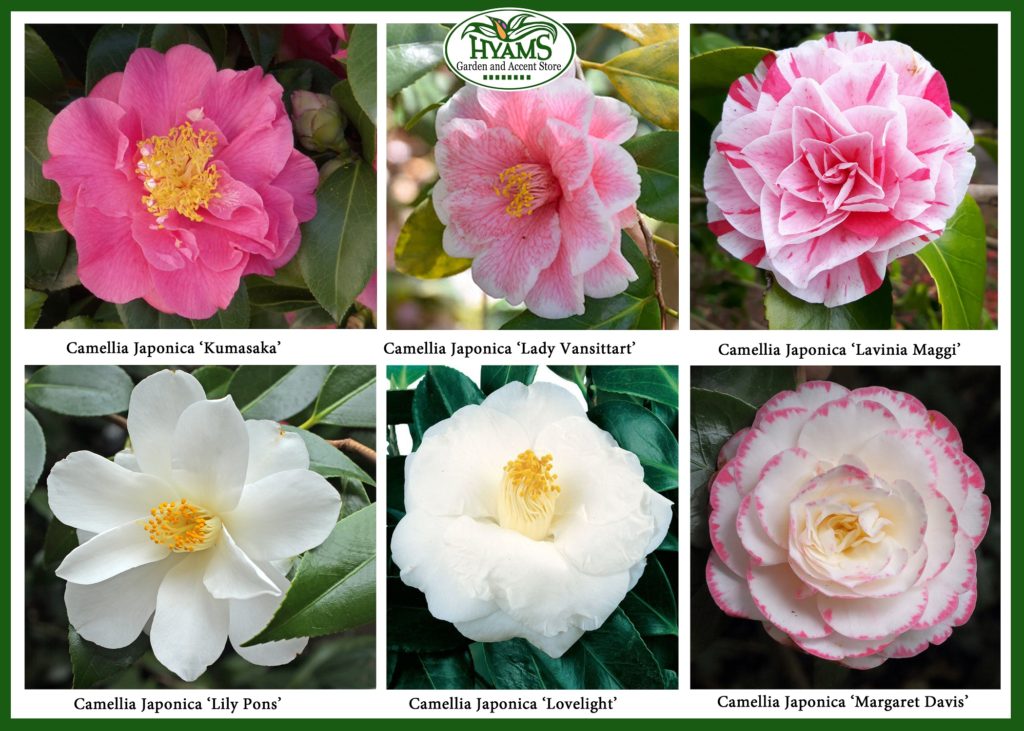
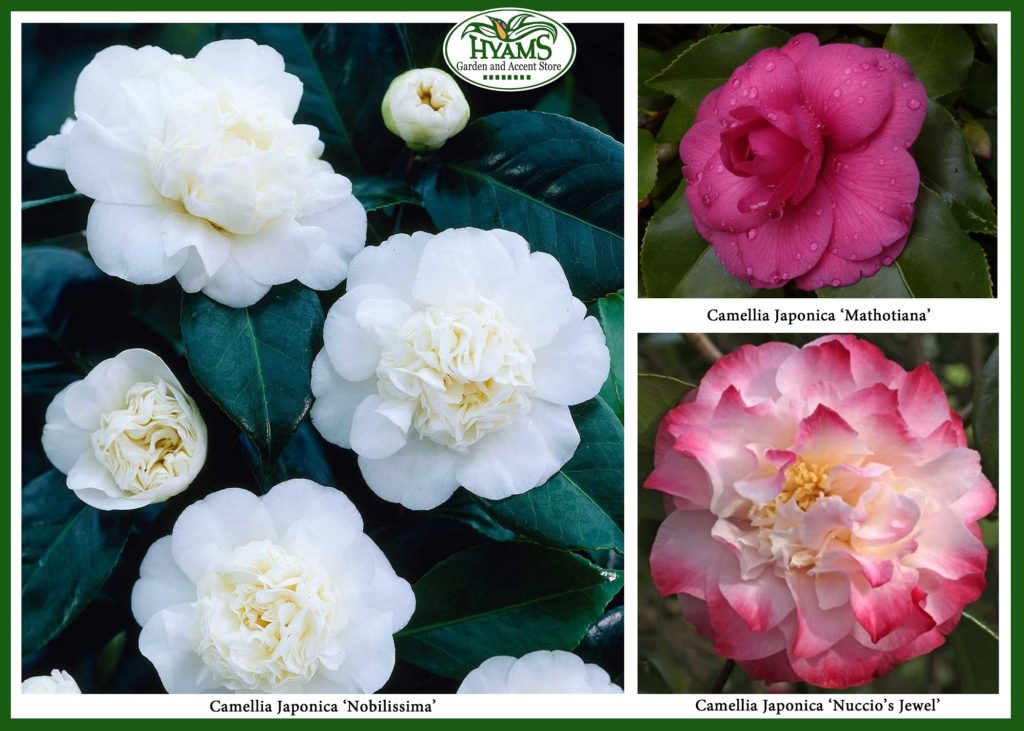
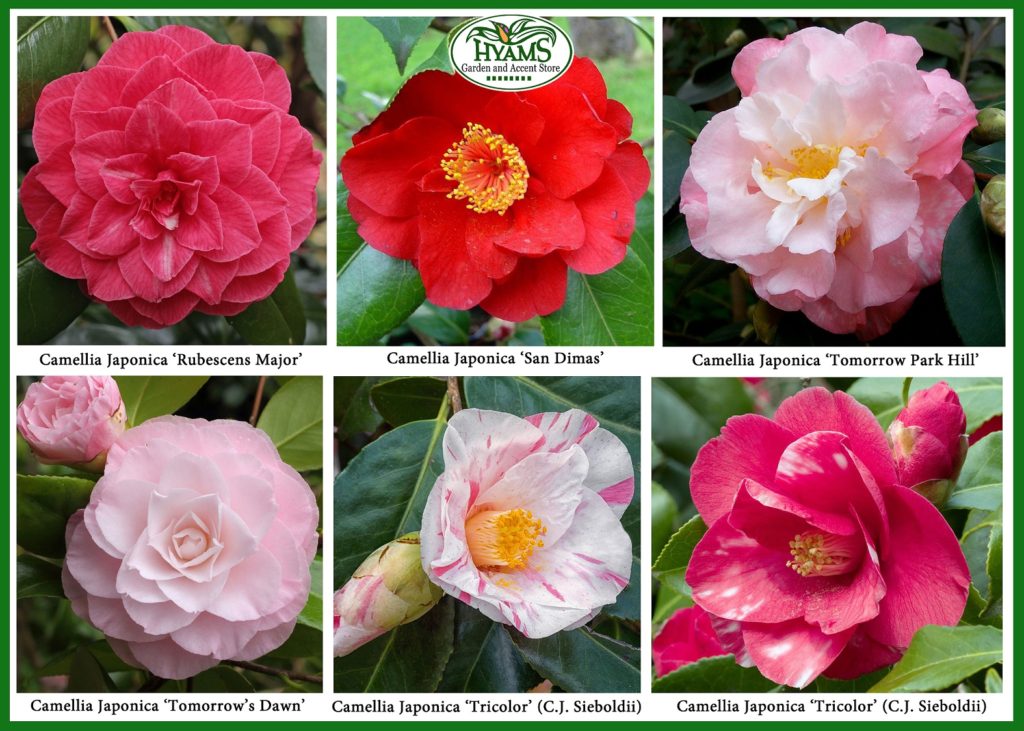
Camellia Leonard Messel (a hybrid of Camellia Reticulata) is an evergreen open shrub with matte dark green large, ovate, leathery leaves. In spring it bears a profusion of large, loose semi double rose-pink flowers. This camellia is fit for zone 7 and 8.
Camelia Nicky Crisp (synonymous with Camellia Pitardii var. Pitardii) is an evergreen, compact, upright slow growing shrub with oblong or broadly elliptic dark green leaves. From late winter to mid spring camellia Nicky Crisp bears a profusion of semi double, pale pink flowers. It is fit for zone 7 to 9.
Camellia Oleifera is an evergreen bushy shrub whose leaves are dark green above and light green beneath. During mid and late fall it bears a profusion of single, usually scented white flowers that are sometimes pinkish. This plant is fit for zone 6 to 9.
Camellia Reticulata is an evergreen shrub or small tree with large, broadly elliptic, leathery dark green leaves. During the spring it bears large, single, rose-pink, salmon-red flowers. If the plant is housed in a glass or sheltered location, it produces larger blooms. It is fit for zone 7 to 8. Camellia Reticulata is a parent shrub and has the following varieties or hybrids: Arch of Triumph (large, loose, peony form, orange-tinted, crimson-pink flowers), Black Lace (large, formal double, deep velvet-red flowers), Captain Rawes (large, semi double, carmine-rose blooms), Dr.Clifford Parks (semi double, peony and anemone form large, flame red flowers), Francie L (large, semi double, salmon-red to deep rose-red flowers), Harold L. Paige (peony-form, large, bright red flowers), Inspiration (semi-double, phlox-pink flowers), Lasca Beauty (large, semi-double, soft-pink flowers), Mandalay Queen (large, semi double, deep rose-pink flowers), Miss Tulare (large, bright red, peony-form flowers), Songzilin (large, formal double, deep red flowers), William Hertrich (very large, semi double or loose peony-form, bright red flowers).
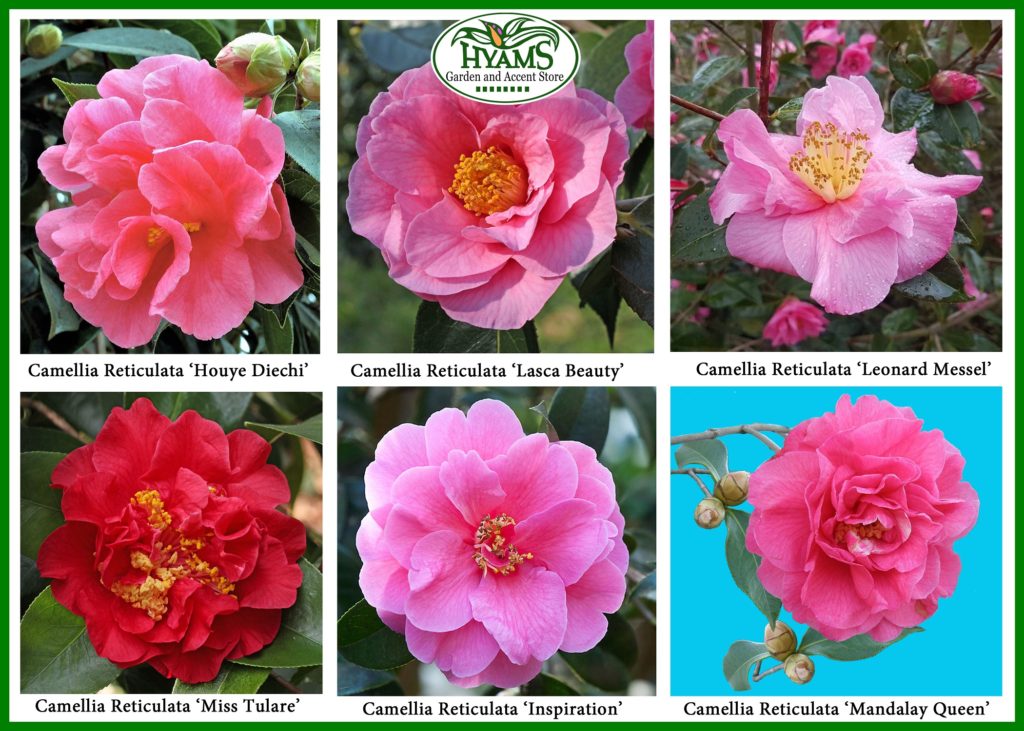
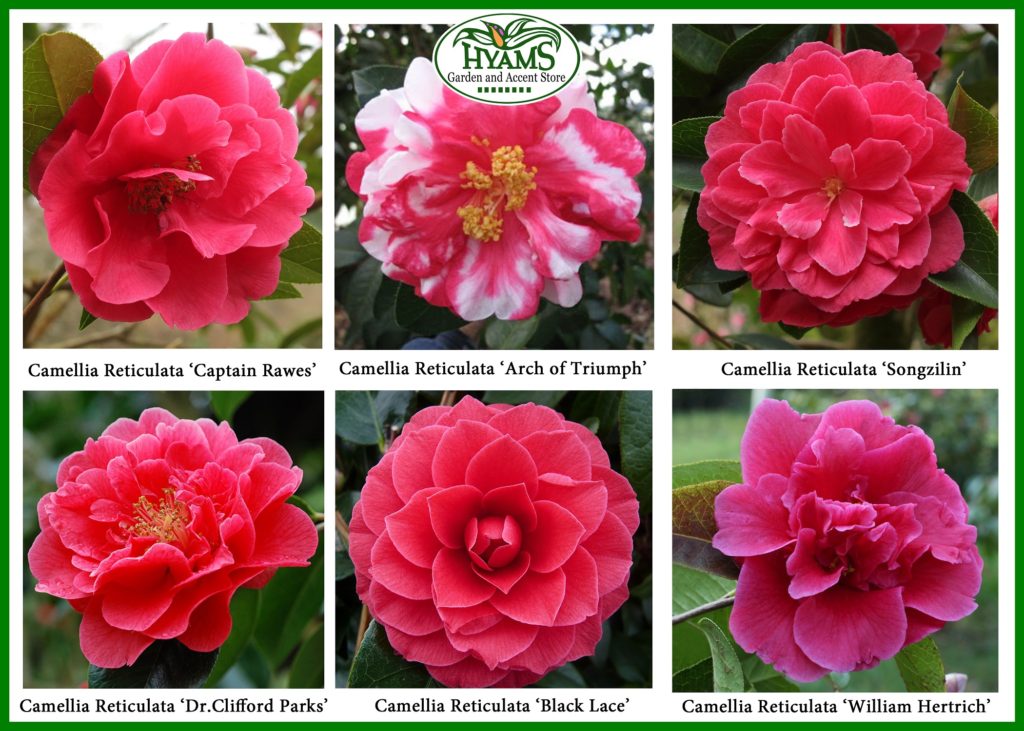
Camellia Rosaeflora is an evergreen spreading shrub with pale green and ovate fine leaves. It bears small, single rose-pink flowers in spring. This variety is fit for zone 7 to 8.
Camellia Saluenensis is a fast-growing evergreen bushy shrub with oblong to elliptic, stiff, dull green leaves. In early spring it produces single white to rose-red flowers. Some forms of Camellia Saluenensis may withstand lower temperatures. This variety is fit for zone 7 to 8.
Camellia Sasanqua is a fast-growing evergreen dense upright shrub with oblong to elliptic, glossy bright green leaves. In fall and early winter it produces fragrant, usually single, white flowers. Occasionally the flowers may turn out to be pink or red. This variety does best in a hot, sunny site and is suited for zone 7 to 8. The following are some of the varieties of Camellia Sasanqua: Hugh Evans (single rose-pink flowers), Jean May (large, peony-form to double pale pink flowers), Narumigata (large, single white flowers, sometimes pink-flushed), Shishigashira (small, semi double to loose peony from pale red flowers).
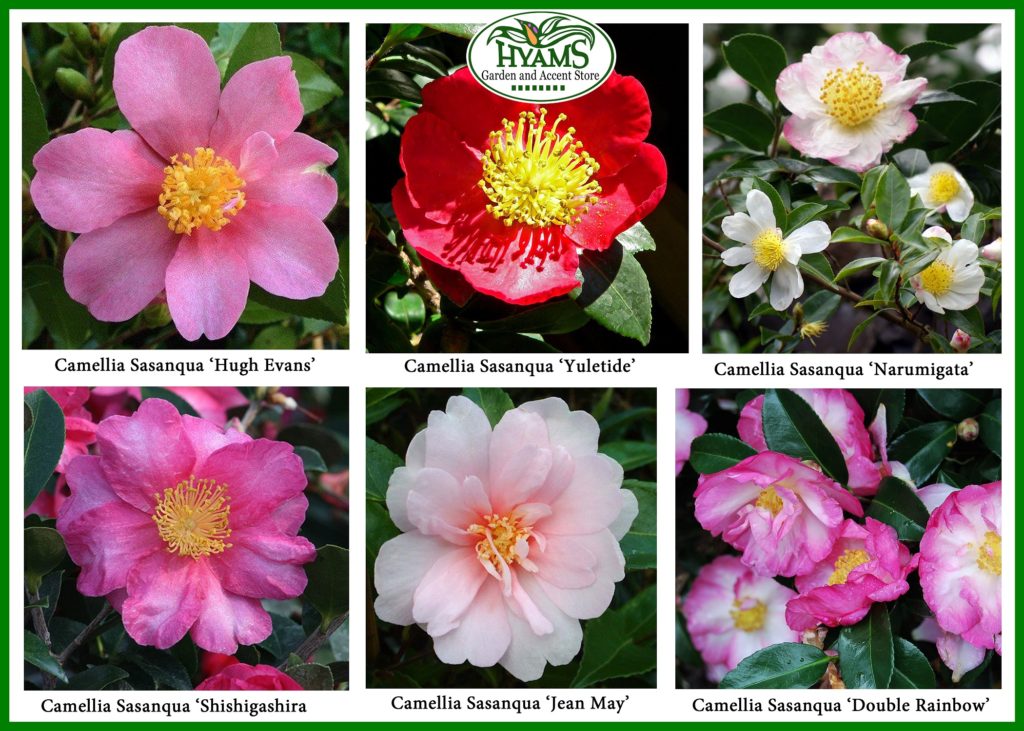
Camellia Spring Festival is an evergreen upright shrub with elliptic, dark green leaves. In mid spring it produces miniature, semi double, pink flowers. This variety is fit for zone 7 to 8.
Williamsii Cultivars are hybrid Camellias and vary greatly in habit, leaves and flowers. Flowers take various forms and sizes. Most of them are in pink shades with some in white and one or two in combined white and pink colors. Very few of Williamsii Cultivars bear red blooms. Many of these varieties start flowering in early spring and delight our hearts with a long blooming season. These hybrid cultivars are fit for zones 7 to 8. The following are the hybrids between camellia and williamsii cultivars: Apple Blossom (single, sweet scented white flowers with pale pink shades), Anticipation (large, peony-form, deep rose-pink blooms), Bow Bells (bell-shaped, single rose-pink flowers with deeper pink centers and veins), Brigadoon (semi double, rose-pink flowers with broad, down-curving petals), Debbie (large, peony-form, rose-pink flowers), Donation (large, semi double, pink flowers), Dream Boat (medium, formal double, pale purplish-pink flowers with incurved petals), E.G. Waterhouse (formal double, pink flowers), Elizabeth de Rothschild (semi double rose-pink flowers), Elsie Jury (large, full peony-form, clear pink flowers), Francis Hanger (single white flowers with gold stamens), Freedom Bell (semi double, bright red flowers), Golden Spanglers (single, deep pink flowers), J.C. Williams (single pink flowers), Joan Trehane (large, rose form, rose-pink flowers), Jury’s Yellow (medium, anemone-form, white flowers with centers of yellow petaloids), Ruby Wedding (anemone to peony form vivid red flowers), Saint Ewe (funnel-shaped, single deep pink flowers), Water Lily (formal double, , mid pink flowers with incurving petals), Wilber Foss (large, broad, peony form, brilliant pink-red flowers).
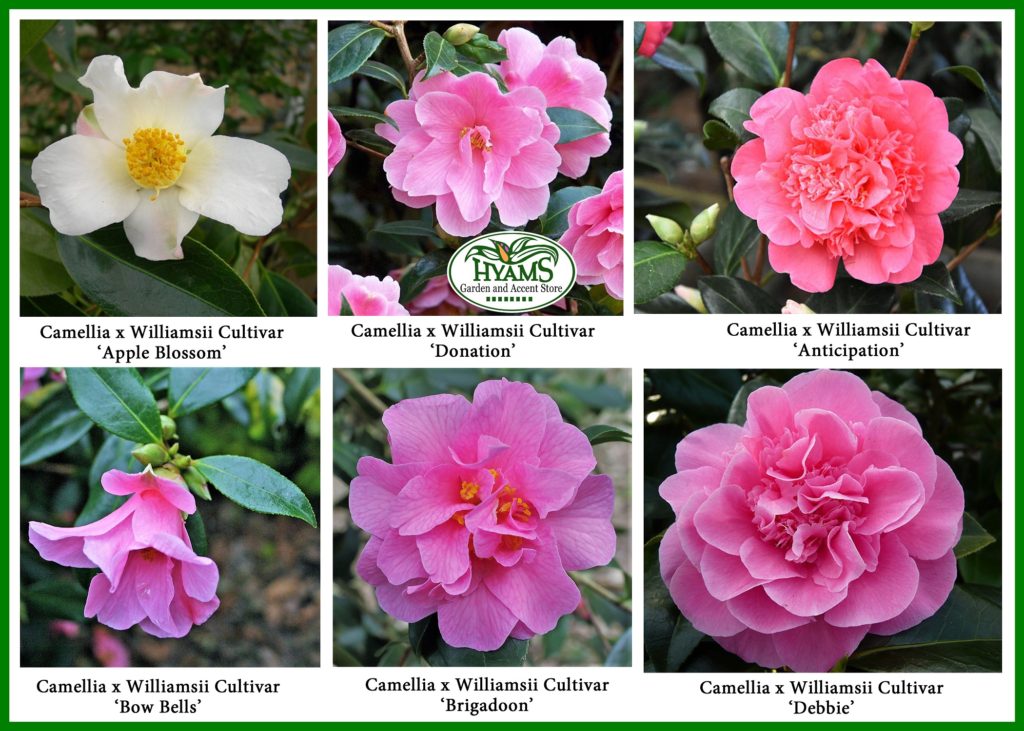
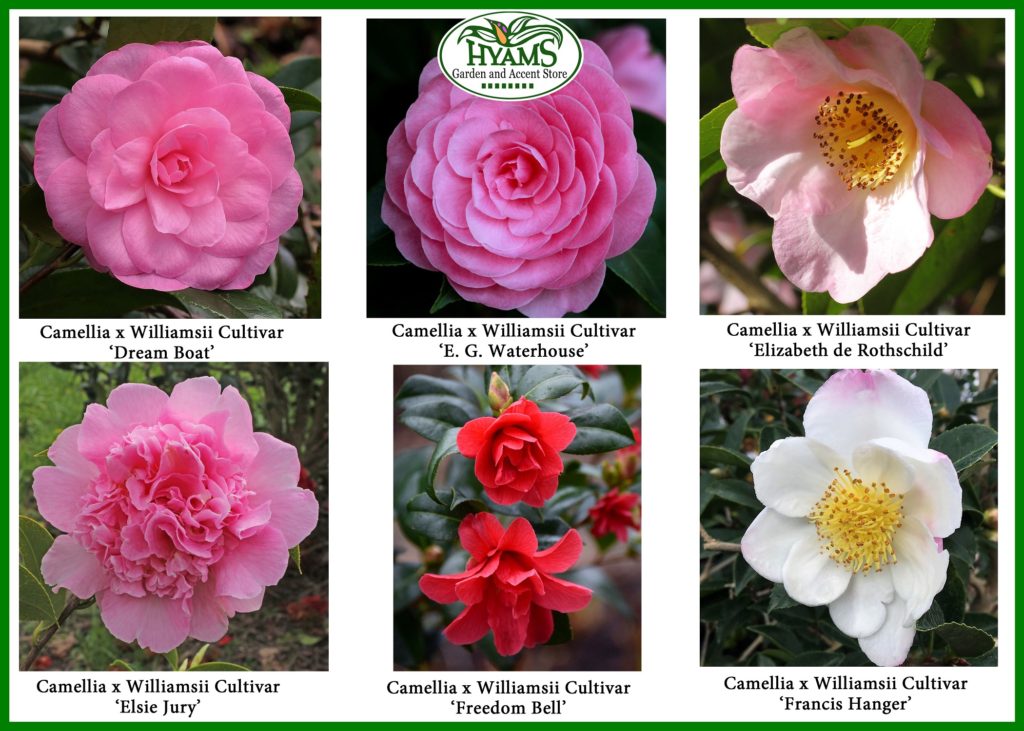
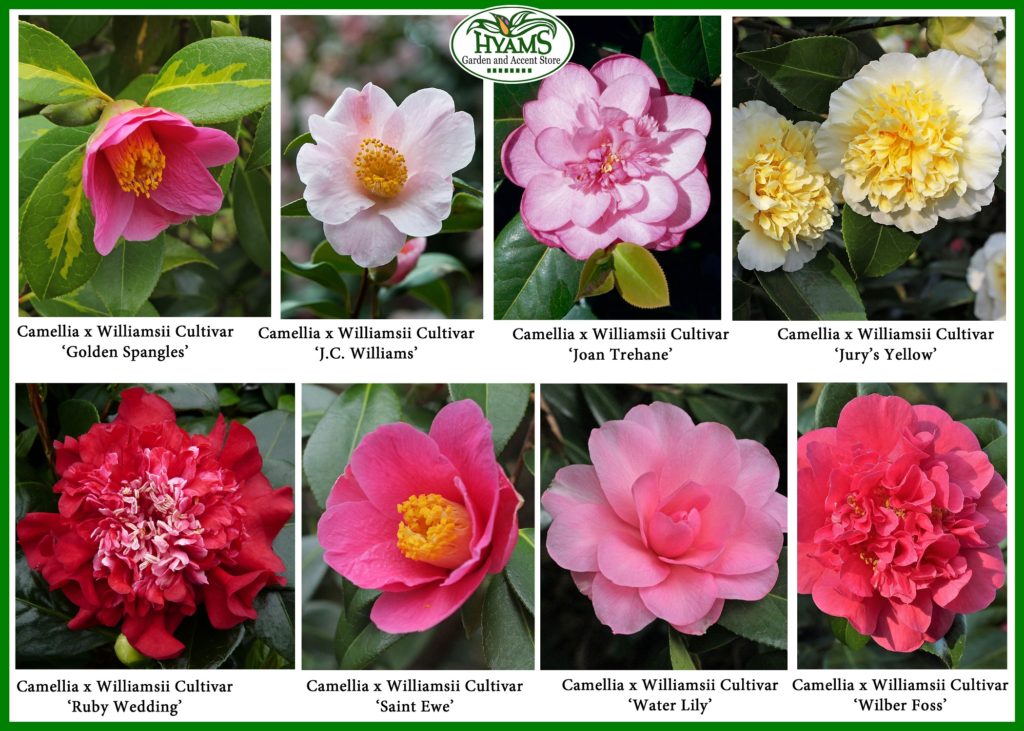
The sheer range of colors, sizes and flowering types makes it difficult to have a single symbolic significance of this incredible flower. Camellias generally embody love, affection and admiration. White camellias stand for adoration and are therefore given to someone who is very much liked. Pink Camellias are offered to a person to make them know how much he or she has been missed as they symbolize longing. Red camellias are used to celebrate love, passion and deep desire.
By Marshal and Jane Upasi
